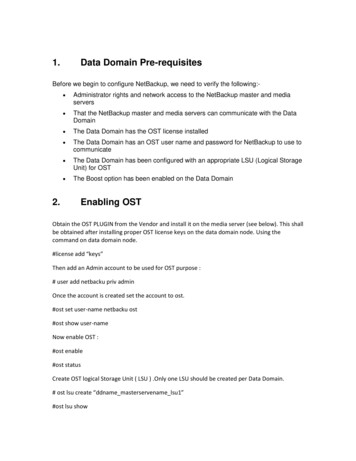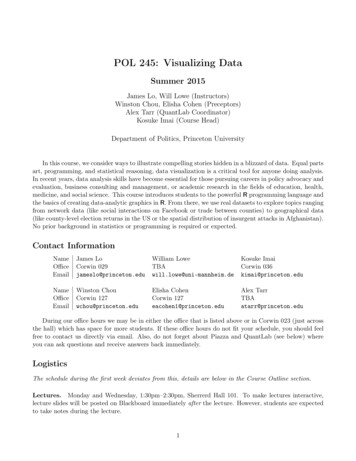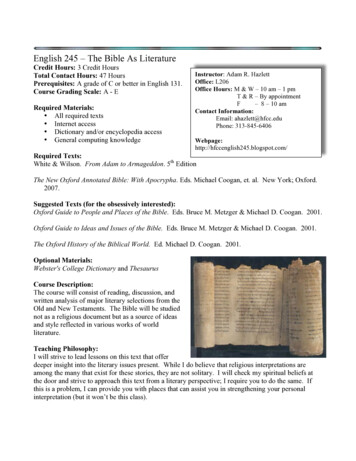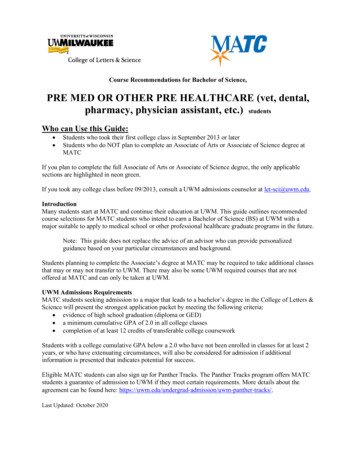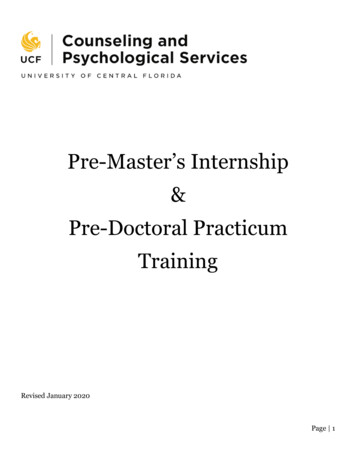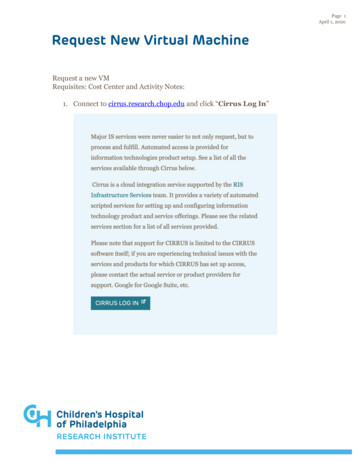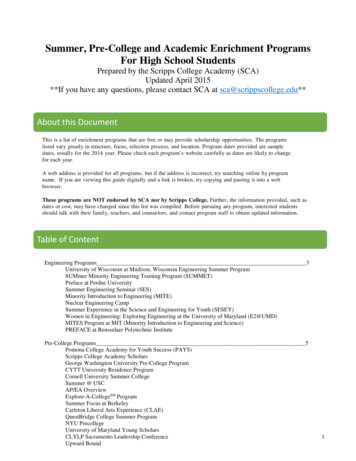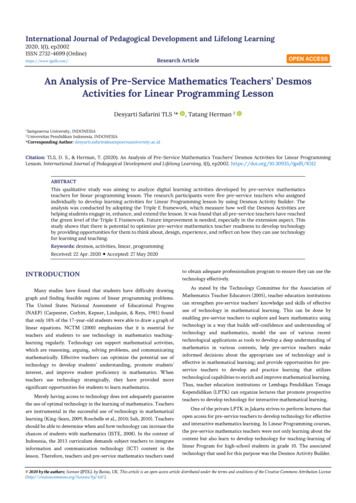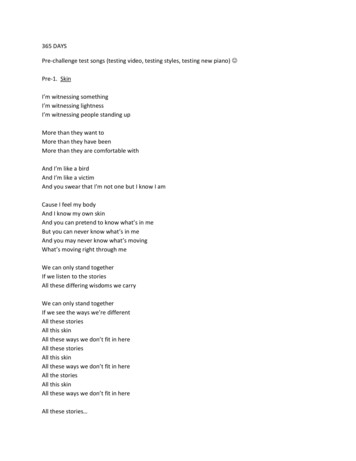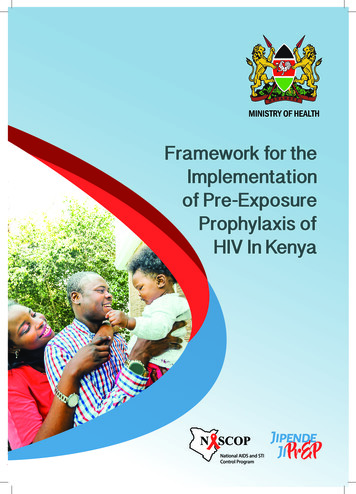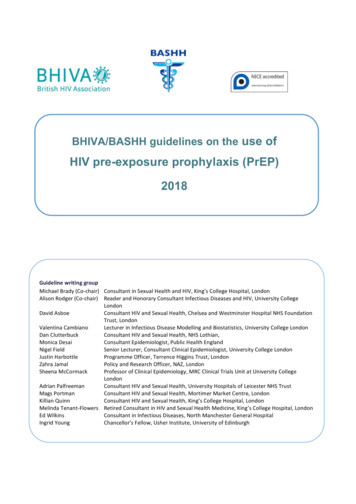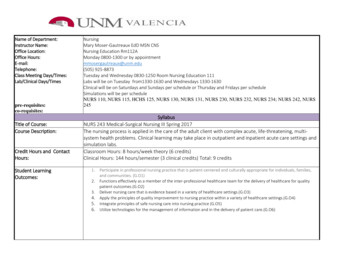
Transcription
Name of Department:Instructor Name:Office Location:Office Hours:E-mail:Telephone:Class Meeting Days/Times:Lab/Clinical Days/Timespre-requisites:co-requisites:Title of Course:Course Description:Credit Hours and ContactHours:Student LearningOutcomes:NursingMary Moser-Gautreaux EdD MSN CNSNursing Education Rm112AMonday 0800-1300 or by appointmentmmosergautreaux@unm.edu(505) 925-8873Tuesday and Wednesday 0830-1250 Room Nursing Education 111Labs will be on Tuesday from1330-1630 and Wednesdays 1330-1630Clinical will be on Saturdays and Sundays per schedule or Thursday and Fridays per scheduleSimulations will be per scheduleNURS 110, NURS 115, HCHS 125, NURS 130, NURS 131, NURS 230, NURS 232, NURS 234; NURS 242, NURS245SyllabusNURS 243 Medical-Surgical Nursing III Spring 2017The nursing process is applied in the care of the adult client with complex acute, life-threatening, multisystem health problems. Clinical learning may take place in outpatient and inpatient acute care settings andsimulation labs.Classroom Hours: 8 hours/week theory (6 credits)Clinical Hours: 144 hours/semester (3 clinical credits) Total: 9 credits1.Participate in professional nursing practice that is patient-centered and culturally appropriate for individuals, families,and communities. (G.O1)2. Functions effectively as a member of the inter-professional healthcare team for the delivery of healthcare for qualitypatient outcomes.(G.O2)3. Deliver nursing care that is evidence based in a variety of healthcare settings.(G.O3)4. Apply the principles of quality improvement to nursing practice within a variety of healthcare settings.(G.O4)5. Integrate principles of safe nursing care into nursing practice (G.O5)6. Utilize technologies for the management of information and in the delivery of patient care.(G.O6)
Required Text(s) andSupporting Materials: Lewis, Diirksen, Heitkemper, Butcher (2014) 9th Ed Medical Surgical Nursing Assessment and Management ofClinical Problems.Pagana, T.J.; Pagana, D.P. (2012). Mosby’s Diagnostic and Laboratory Test Reference. (11th ed). St. Louis:Elsevier/Mosby.( or other current manual)Potter, P.A., Perry, A.G. (2015) Essentials of Nursing practice (8th ed.). St. Louis: Elsevier/MosbyMorris, D.G. (2009) Calculate with Confidence. (5th ed.). St. Louis: Elsevier/MosbyDeglin, Vallerand, Davis’s Drug Guide for Nurses, latest edition, F. A. Davis ( or other current drughandbook)Kaplan resourcesBlackboard Learn ContentsLiability and needle stick insurance, uniform, stethoscope, penlight, proper identification Disabilities Policy:In accordance with University Policy 2310 and the Americans with Disabilities Act (ADA), any student needingacademic accommodations should first contact Equal Access Services at 925-8560 (Student Services Bldg.) It is alsoimperative that you take the initiative to bring such needs to the instructor’s attention, as your instructor is notlegally permitted to inquire. Students who may require assistance in emergency evacuations should contact theinstructor as to the most appropriate procedures to follow.Student Handbook PoliciesStudents are expected to read and be familiar with the policies as stated in the student handbook. Studentsneed to pay close attention to the following policies: Attendance Theory/lab/clinical Cell Phone useUniform policy Medication math examStudents may wear casual professional for theory class. Lab/clinical uniforms are to be worn on lab/clinical oroutings.
Course MatrixExam 118.75%187.5 pointsExam 218.75%187.5 pointsExam 318.75%187.5 pointsExam 418.75%187.5 pointsPharmacology Exam with remediationSimulation 10% total100 pointsKaplan Exam w remediation5% total100 pointsEvidenced Based Paper and Presentation 10%100 pointsTOTAL1000 points100%Evaluation/Grading Policies: Theory Grading Policy: There will be four(4) theory tests in NURS 243 The theory unit tests must achieve a minimum cumulative grade of 75%, which will constitute 75% of the student’s final grade.Each theory examination will contain five (5) dosage/calculation problems. Course average must achieve a minimum cumulative grade of 75% There are no exam retakes, dropping of the lowest grade or extra credit. Other methods of evaluation will amount to 25% of a student’s total grade and will not substitute for a passing grade in the testingcomponent of the grade calculation. A failing grade will not be rounded to a passing grade (example: 74.99% does not round to 75%. A passing score in the clinical portion will not be considered until the 75% test average and the 75% course average requirementsare met.Clinical Grading Policy: All clinical/lab rotations will be graded with a “Pass/Fail.” To pass, a student must successfully complete all requiredclinical hours, assignment work, and Meet the following performance evaluation criteria: Student is expected to Meet Expectations for Clinical Evaluation Competencies (CEC) in order to pass the course.It is understood student MAY NOT meet all of the CECs in the beginning weeks of the course. It is expected the student will be meet all of theCECs within the last weeks of the clinical experience.If student Meet Expectations in all CECs, it is optional for the course instructor of record to write a narrative note.If student DOES NOT Meet Expectations in one competency, the course instructor of record is required to write narrative note.If a student DOES NOT Meet Expectations in one competency two weeks in a row, the course instructor of record will discuss with studentoptions for improvement.
If a student DOES NOT Meet Expectations in one competency three weeks in row, the student will be placed on Clinical Probation and a writtenimprovement plan developed by the course instructor of record and signed by both that instructor, the program director, and the student.Mathematics Grading Policy: To insure the safety of the clients, at the beginning of the FOURTH (4TH) SEMESTER the student must pass adosage/calculation test with a minimum of 90% after maximum of three (3) attempts before they are permitted to enter the clinicalsetting. The inability to successfully pass the dosage/calculation test in the maximum attempts will result in failure of the clinical portion ofthe course and requires remediation prior to applying for readmission. Remediation consists of successfully passing an approved nursingdosage/calculation course. There will be dosage and calculation math questions on all theory examinations.Kaplan PolicyThe UNM-Valencia Nursing Program has adopted a comprehensive assessment and review program from Kaplan Nursing. The intent of thisprogram is to provide students with the tools they need to be successful in the nursing program and on the NCLEX-RN. The Kaplan programis a component (5%) of the student’s grade in all nursing classes.Kaplan also provides both online practice and proctored tests. The practice tests are designed for student self-assessment and providestudents with immediate question feedback and rationales. Instructors provide the students with the practice test directions as needed. Inorder for the student to take the Kaplan proctored test, each student must have completed the online practice test. Grade points forpractice tests are awarded based on the score achieved. The 5% of each course grade allotted to Kaplan will be derived from three sourcesand totaled for a possible 100 points.Focused Review (practice) Test in Content Area80-100%60-79.9%40-59.9%Less than 39.9%Integrated (proctored) Test in Content Area 60th percentile50–59.9th percentile40–49.9th percentile 39.9th percentileRemediation of Integrated TestRemediates all questions minimum of 45 secondsRemediates only wrong questions minimum of 45 secondsRemediates 50% minimum of 45 secondsDoes not remediatePoints252015025201505040300Total points:
This Syllabus, including the Course Schedule, is subject to change at the discretion of the Instructor in accordance with UNM Valencia AcademicPoliciesUnit Exams -75% of total grade- 150points/Unit Exam Points (must equal aminimum of 562.5 total)Exam 2Exam 3Exam 4Exam 5Unit Exam Percentage (must equal75% average)Exam 1 %Exam 2 %Exam 3 %Exam 4 %Exam 5TotalAverage %EB PaperEB PresentationTotalEB Paper %EB Presentation %TotalExam 1Evidenced Based Paper and Presentation10% of Total Grade 75points paper25 Points presentationTotal 100 pointsKaplan-5% of grade- 100 pointspossibleTotal – 100% (1000 points)Clinical Evaluations Clinical grade ispass/fail and is not considered untiltheory requirements are met.)Pass FailTotal PointsClinical PointsClinical Eval 1Clinical Eval 2Clinical Eval 3Clinical Eval 4Clinical Eval 5Clinical Eval 6Clinical Eval 7Total PointsTotal Percentage %Clinical PercentageClinical Eval 1 %Clinical Eval 2 %Clinical Eval 3 %Clinical Eval 4 %Clinical Eval 5 %Clinical Eval 6 %Clinical Eval 7 %Total Percentage %Course Schedule
WKDate11/17/2017ObjectivesSyllabus/Course Review Medication Math review 11/18/2017 21/24/2017 Describe the pathophysiology, clinical manifestations, andcollaborative care of prostate cancer. (SLO2 )Explain the nursing management of prostate cancer(SLO2 )Specify the pathophysiology, clinical manifestations, andnursing and collaborative management of prostatitis andproblems of the penis and scrotum. (SLO 2,3)Explain the clinical manifestations and collaborative care oftesticular cancer. (SLO2 )Describe the pathophysiology, clinical manifestations, andcurrent nursing and collaborative management of problemsrelated to male sexual function. (SLO 2,3)Summarize the psychological and emotional implicationsrelated to male reproductive problems. (SLO5 )Differentiate the etiology, clinical manifestations, diagnosticstudies, collaborative care, and nursing management ofseizure disorders, multiple sclerosis, Parkinson’s disease, andmyasthenia gravis. (SLO2,3 )Describe the clinical manifestations and nursing andcollaborative management of restless legs syndrome,amyotrophic lateral sclerosis, and Huntington’s disease.(SLO2,3 )Explain the potential impact of chronic neurologic disease onphysical and psychologic well-being. (SLO1 )Outline the major goals of treatment for the patient with achronic, progressive neurologic disease. (SLO1 )Explain the physiologic mechanisms that maintain normalintracranial pressure.Describe the common etiologies, clinical manifestations, andcollaborative care of the patient with increased intracranialpressure.Fall 2016Topic/ContentNursing assessmentand care of patientswith selectedendocrine problemsLewis Chapter 55PrepLewis Chapter 56, 59Nursing care ofpatients with chronicneurosensoryalterations1. Seizuredisorders2. Parkinsonsdisease3. MyasthenaGravis4. Multiplesclerosis5. Restless legsyndrome6. AmyotropicLateralSclerosis7. Huntington’sdiseaseReview A&P of Nervous systemLewis Chapter 57Nursing Managementof Acute IntracranialProblemsStrokeGlascow Coma scale NCLEX Review Questions Pre-Test Case Studieso Patient with Head Injury
21/25/2017 31/31/2017 Describe the collaborative and nursing management of thepatient with increased intracranial pressure. (SLO2,3,4)Differentiate types of head injury by mechanism of injury andclinical manifestations. (SLO1,5)Describe the collaborative care and nursing management ofthe patient with a head injury.(SLO 1,2,6)Compare the types, clinical manifestations, and collaborativecare of patients with brain tumors.(SLO 1,2)Discuss the nursing management of the patient with a braintumor.(SLO1)Describe the nursing management of the patient undergoingcranial surgery.(SLO1)Differentiate among the primary causes, collaborative care,and nursing management of brain abscess, meningitis, andencephalitis.(SLO3)Describe the incidence of and risk factors for stroke. (SLO3)Explain mechanisms that affect cerebral blood flow. (SLO1)Compare and contrast the etiology and pathophysiology ofischemic and hemorrhagic strokes. (SLO 1,4)Correlate the clinical manifestations of stroke with theunderlying pathophysiology. (SLO1)Identify diagnostic studies performed for patients withstrokes. (SLO3)Differentiate among the collaborative care, drug therapy, andsurgical therapy for patients with ischemic strokes andhemorrhagic strokes. (SLO1,5)Describe the acute nursing management of a patient with astroke.(SLO5)Explain the etiology, clinical manifestations, collaborativecare, and nursing management of Guillain-Barré syndrome,botulism, tetanus, and neurosyphilis. (SLO1)Describe the classification of spinal cord injuries andassociated clinical manifestations. (SLO 1,2,3)Describe the clinical manifestations, collaborative care, andnursing management of neurogenic and spinal shock. (SLO1,3,4)Relate the clinical manifestations of spinal cord injury to thelevel of disruption and rehabilitation potential. (SLO 1,5)Describe the nursing management of the major physical andpsychologic problems of the patient with a spinal cord injury.(SLO 2,3,4)o LewisChapter 58NursingManagementof AcutestrokeLewis Chapter 61Nursing Managementof Peripheral andSpinal cord ProblemsPatient with MeningitisNIH stroke scaleRead - Textbook (Chapter 58, pp. 1388-1412)Review - Evolve Resources NCLEX Review QuestionsPre-TestAnswer Guidelines for Case StudyRationales for Bridge to NCLEX Examination QuestioCase Studieso Patient with Hypertension and Strokeo Patient with StrokeTable 58-7 - Emergency Management: StrokeReview - Clinical Companion Bell’s PalsyCarpal Tunnel SyndromeGuillain-Barre SyndromeSpinal Cord InjurySpinal Cord TumorsNCLEX Review QuestionsPre-TestCase Studyo Patient with Spinal Cord Injury
32/1/2017 42/7/2017 Describe the effects of spinal cord injury on the older adultpopulation. (SLO1,2)Explain the types, clinical manifestations, collaborative care,and nursing management of spinal cord tumors.(SLO1,2)Differentiate the pathophysiology, clinical manifestations, andcollaborative care of different types of aortic aneurysms.(SLO1,2,3)Select appropriate nursing interventions for a patientundergoing an aortic aneurysm repair. (SLO 1,4)Describe the pathophysiology, clinical manifestations,collaborative care, and nursing management of aorticdissection.(SLO1,3,5)Describe the etiology, pathophysiology, and clinicalmanifestations of infective endocarditis and pericarditis.(SLO1,3,4)Describe the collaborative care and nursing management ofthe patient with infective endocarditis and pericarditis.(SLO2,4)Differentiate the etiology, pathophysiology, and clinicalmanifestations of myocarditis.(SLO1,2)Describe the collaborative care and nursing management of apatient with myocarditis.(SLO1,2)Differentiate the etiology, pathophysiology, and clinicalmanifestations of rheumatic fever and rheumatic heartdisease.(SLO1,3)Describe the collaborative care and nursing management ofthe patient with rheumatic fever and rheumatic heartdisease.(SLO1,2)Relate the pathophysiology to the clinical manifestations anddiagnostic studies for the various types of valvular heartdisease.(SLO1,6)Describe the collaborative care and nursing management ofthe patient with valvular heart disease.(SLO2,4)Relate the pathophysiology to the clinical manifestations anddiagnostic studies for the different types ofcardiomyopathy.(SLO1,6)Compare the nursing and collaborative management ofpatients with different types of cardiomyopathy.(SLO 1,2)Exam 1 (Chapter 55,56,57,58,59,61)Relate the etiology and pathophysiology of coronary arterydisease (CAD), angina, and acute coronary syndrome (ACS) tothe clinical manifestations of each disorder. (SLO 1,Lewis Chapters 37,38Care of Patients withVascular ProblemsCare of Patients withInflammatory andStructural HeartDisordersReview - Clinical Companion CardiomyopathyEndocarditis, InfectiveMyocarditisPericarditis, AcuteRheumatic Fever and Heart DiseaseValvular Heart DiseaseNCLEX Review QuestionsPre-TestCase Study Patient With Rheumatic Fever and Heart DiseaseLewis Chapter 34, 36REVIEW - Clinical Companion Acute Coronary Syndrome
Describe the nursing role in the promotion of therapeuticlifestyle changes in patients at risk for CAD.(SLO 3,2)Differentiate the precipitating factors, clinical manifestations,collaborative care, and nursing management of the patientwith CAD and chronic stable angina.(SLO1,2,4,5)Explain the clinical manifestations, complications, diagnosticstudy results, and collaborative care of the patient with ACS.(SLO 1,6)Evaluate commonly used drug therapy in treating patientswith CAD and ACS.(SLO3,5)Prioritize key components to include in the rehabilitation ofpatients recovering from ACS and coronary revascularizationprocedures. (SLO2,3)Differentiate the precipitating factors, clinical presentation,and collaborative care of patients who are at risk for or haveexperienced sudden cardiac death.(SLO 1,2,3)42/8/2017 Cont. from 2/7/201752/14/2017 Differentiate between acute kidney injury and chronic kidneydisease.(SLO1,3)Identify criteria used in the classification of acute kidney injuryusing the acronym RIFLE (risk, injury, failure, loss, end-stagekidney disease).(SLO1,5)Describe the clinical course of acute kidney injury.(SLO1,3)Explain the collaborative care and nursing management of apatient with acute kidney injury.(SLO 2,4)Define chronic kidney disease and delineate the five stages ofchronic kidney disease based on the glomerular filtration rate.(SLO 1,3)Differentiate among renal replacement therapy options forindividuals with end-stage kidney disease. (SLO 1,3)Compare and contrast nursing interventions for individuals onperitoneal dialysis and hemodialysis.(SLO 1,3)Discuss the role of nurses in the management of individualsthat receive a kidney transplant.(SLO 1,3) Care of Patients withAcute CoronarySyndrome Angina, Chronic StableCoronary Artery DiseaseMyocardial InfarctionDysrhythmiasPacemakersCharacteristics of Common DysrhythmiasReview - Evolve Resources Lewis Chapter 47Care of Patients withRenal Disorders &Care of Patients withAcute Kidney Injuryand Chronic KidneyDiseaseNCLEX Review QuestionsCase Studyo Patient with Coronary Artery Disease and ACoronary SyndromeReview - Clinical Companion Kidney Disease, ChronicKidney Injury, AcuteDialysisReview - Evolve Resources NCLEX Review QuestionsPre-TestCase Studieso Patient With Glomerulonephritis andDiseaseo Patient With Kidney TransplanteTable 47-1: Manifestations of Acute KidneyeTable 47-2: Case Study: Intrarenal Cause of Acute KFollowing Surgery
52/15/2017 Differentiate among the types of viral hepatitis, includingetiology, pathophysiology, clinical manifestations,complications, and collaborative care. (SLO1)Describe the nursing management of the patient with viralhepatitis.(SLO1,2)Describe the pathophysiology, clinical manifestations,complications, and collaborative care of the patient withnonalcoholic fatty liver disease. (SLO 1,2,3)Explain the etiology, pathophysiology, clinical manifestations,complications, collaborative care, and nursing management ofthe patient with cirrhosis of the liver.(SLO 1,2,3)Describe the clinical manifestations and management of livercancer.(SLO 1,4)Differentiate between acute and chronic pancreatitis relatedto pathophysiology, clinical manifestations, complications,collaborative care, and nursing management.(SLO 1,2,4,5)Explain the clinical manifestations and collaborative care ofthe patient with pancreatic cancer.(SLO 1,2)Describe the pathophysiology, clinical manifestations,complications, and collaborative care of gallbladderdisorders.(SLO 1,2)Describe the nursing management of the patient undergoingsurgical treatment of cholecystitis and cholelithiasis.(SLO1,2,3)Relate the pathophysiology of acute and chroniccomplications of diabetes mellitus to the clinicalmanifestations. (SLO1,2)Explain the collaborative care and nursing management of thepatient with acute and chronic comp
The UNM-Valencia Nursing Program has adopted a comprehensive assessment and review program from Kaplan Nursing. The intent of this program is to provide students with the tools they need to be successful in the nursing program and on the NCLEX-RN. The Kaplan program is a component (5%) of the
